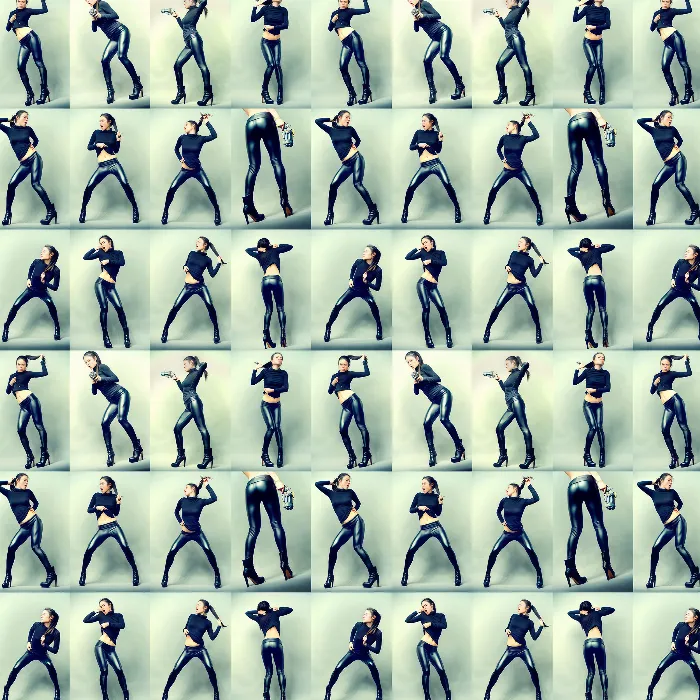In addition to having your own distinctive style, you can also stand out by ensuring that your own photos are at least technically almost perfect. And special image ideas are always a guarantee that photos will stand out from the crowd and therefore attract attention.
I can't teach you creativity. But I can give you countless tips, most of which I have acquired myself over the course of 20 years of model photography. This will help you to create sophisticated photos more quickly. So that you have your head free to really realize your own ideas creatively.
Good luck with this!
Jens Brüggemann, August 2013
Figure 01: I hope you enjoy reading this, Jens Brüggemann, www.jensbrueggemann.de.
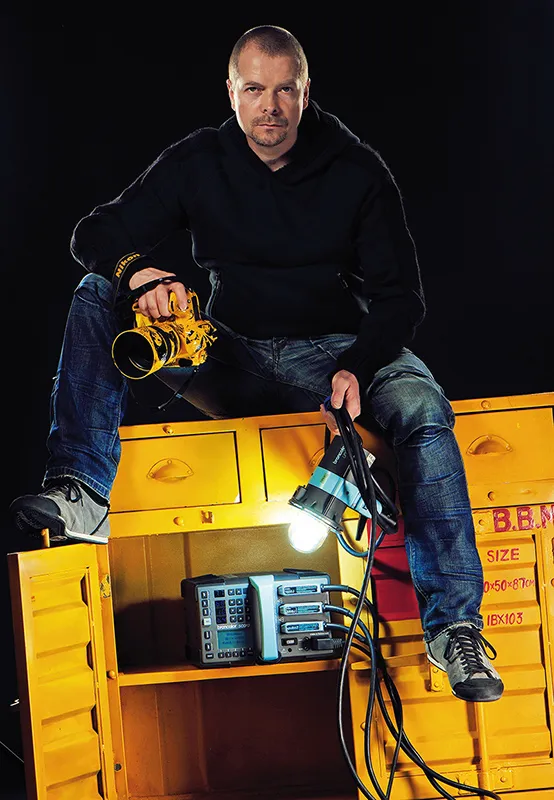
(Photo © 2013: Lilly)
Here is an overview of the individual chapters:
Part 1 - Photographing "models"
Part 2 - The sensible (!) equipment
Part 3 - Finding suitable models
Part 4 - Finding a location
Part 5 - Developing image ideas
Part 6 - Image composition tips
Part 7 - Styling tips
Part 8 - Skillfully lighting models
Part 9 - Efficient teamwork
Part 10 - Posing tips
1 Photographing "models
Model photography is "in". Newspapers are full of model photos; and recently you can also see how model photographers (supposedly) work on TV. And even if everyone is actually aware that the events shown on TV are staged "making ofs" produced for the TV format, since the first season of Germany's Next Top Model everyone thinks they can have a say in the modeling business ...
But what does reality really look like? What makes a good model photographer?
Let's look at the other side first. What makes a good model? What is really important to be able to work successfully as a model?
Nowadays, anyone can become a model. The prerequisite is a more or less good appearance. However, this is not easy to judge. When in doubt, it's a matter of taste. "Fortunately, because the beautiful (model) world would be boring if all photographers chased after a single ideal of beauty. The different tastes ensure that the world is "colorful" and never boring. (Imagine what it would be like if all model photos showed the same type of woman: How boring it would be to look at corresponding photos!) Diversity, on the other hand, is what makes photography interesting, and this also applies to model selection!
In addition to looks, "photogenicity" is actually the decisive factor in whether a person is suitable as a model or not. Not all good-looking people are photogenic. And not all photogenic people are "eye-catchers" when they are out and about on the street. Many great models are rather inconspicuous in everyday life! But when they stand in the light of the flashbulbs with their make-up on, they show what they are made of. It was not uncommon for me to be downright surprised at how the inconspicuous girl next door turned into a man-killing vamp ...
Many people call themselves "models" or "photo models" these days. There is neither an exam to become a model nor any training. The term is not protected, which is why anyone can call themselves a model if they have ever stood in front of the camera of a "photographer" (also not a protected term; a photographer is someone who operates a camera) or at least intends to. (The subjective self-assessment of some self-proclaimed "models" does not always lead to a promising career ...)
On the other hand, there are many countless "talents" who are either pupils or students or have some other professional activity and yet act so perfectly in front of the camera that they more than deserve to be called "photo models".
Figure 1-1: Elida is a very good model. I "discovered" her on the street while shopping. Within just a few shoots, she has developed into a really great model. So talent - as well as a professional attitude and way of working - is also part of it! And when the results are as fantastic as these, the model can be proud of her photos! I added the canvas effect to the photo in Photoshop. It goes well with the muted colors. The photo was taken a few months ago during my Ibiza photo workshop in May 2013.
As I didn't have my camera with me, I borrowed the model's camera to take this photo. It had rained shortly beforehand (rarely enough on Ibiza!) and the sky was still cloudy, which resulted in a very nice lighting mood. In addition, the colors appeared paler than usual in sunlight, which suited my picture idea better. Nikon D3000 with 2.8/105mm macro Nikkor. 1/500 second, Blender 2.8, ISO 100.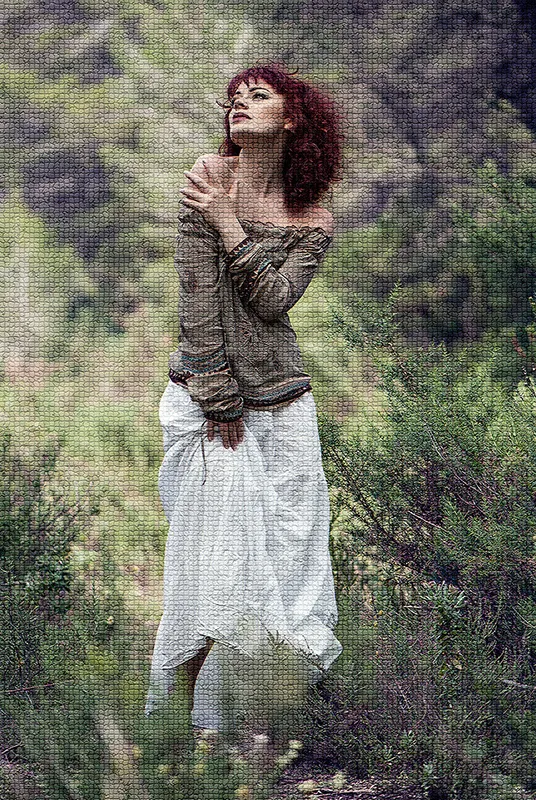
(Photo © 2013: Jens Brüggemann - www.jensbrueggemann.de)
However, one thing is essential for suitability as a model: professionalism, which above all includes reliability and punctuality! Even the most beautiful model is no use to me as a photographer if she doesn't show up for the shoot, for example because she partied too late the day before. Or if the booked workshop model arrives 2 hours late and the workshop is almost over.
If the photographer cannot rely on the model, then there is only one consequence: ending the collaboration, because what photographer wants to take the risk before important photo shoots, for commissioned work, that the model is only 50% likely to show up for the shoot? Professional photography is about earning a living, securing your livelihood. There is no room for unreliable models.
On the other hand, there are just as many unreliable photographers. If you promise to send your model 10 edited photos, you should keep that promise!
Figure 1-2: An intense portrait for which I had to take more than 250 shots before I finally felt that the image of this young woman really did justice to her personality. If you want to photograph more than just appearances, you can't be finished in 10 or 15 minutes. This requires an intensive study of the person being photographed. Of course, there are always lucky shots, but as a rule, good photos are the result of hard work. That's why (properly executed) (portrait) photo shoots involve intensive collaboration, in which the photographer and model contribute to the result in roughly equal measure and with full concentration.
For this reason alone, it should go without saying that the model should receive a few of the best results. Nikon D3X with 2.8/105mm Macro Nikkor. 1/160 second, Blender 3.2, ISO 100.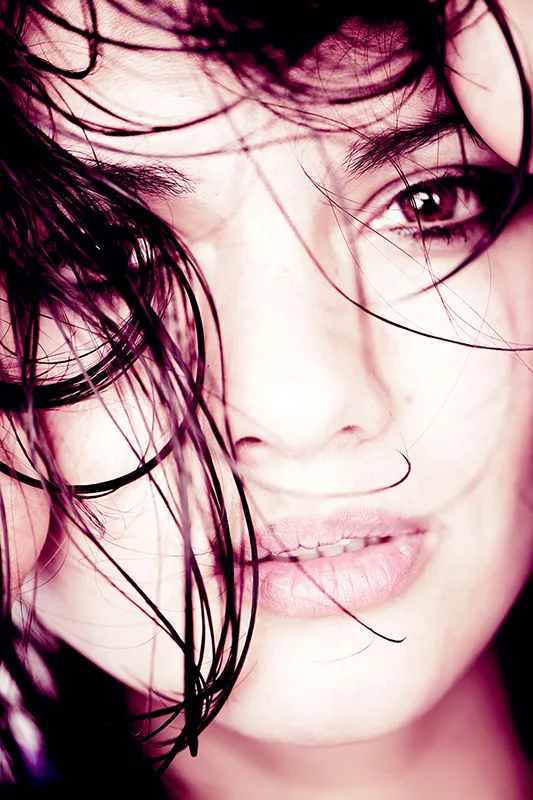
(Photo © 2010: Jens Brüggemann - www.jensbrueggemann.de)
So what makes a good model photographer? The photo results must please (the client, the models, the public, ...)!
In the following parts of this tutorial, you will find out how to achieve better results, what is important in model photography and what you need to pay attention to!
Please note, however, that it's not just the result that counts; creativity, a professional approach, reliability, commercial thinking, flexibility and seriousness are also part of the toolkit of every photographer who wants to earn money with their photos on a full-time or part-time basis.
Figure 1-3: And practice is also part of being a photographer! A good way to make quick and lasting progress is to attend photography workshops. This photo was taken at my Ibiza workshop in May 2013. In order to soften contrasts, lighting technology sometimes has to be used in the photos if the sky is not to appear washed out white in the photos. That's why I always have the Ranger Quadra RX Hybrid mobile battery-powered flash system from Elinchrom as well as brighteners and shades from California Sunbounce with me for the participants to use during my workshops abroad.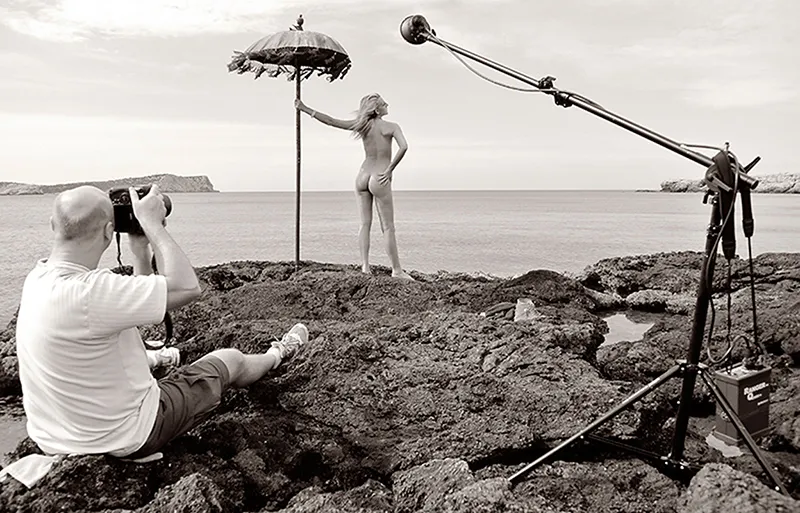
(Photo © 2013: Jens Brüggemann - www.jensbrueggemann.de)
Note: Since "model photography", as we have seen, is a rather broad term, the individual areas will be briefly introduced and differentiated from each other in this first chapter. The most important (photographic) characteristics are briefly explained in each case, as are the demands placed on photographers in the respective subject area.
1.1 People photography
People photographers must be communicative. They must have an interest in other people, as well as a willingness to work flexibly and adapt to the subject (and, in the case of commissioned work, the briefing). And only those who are curious and open-minded will enjoy people photography.
In contrast to street photography, intensive engagement with the person being photographed is an essential feature of people photography. It is not so much the (secret) observation, but the "communication" with the subject that makes a successful people photographer.
It is also important to emphasize a picture's message, at least when people photography is used to stage an advertising message. This sets it apart from reportage photography.
Figure 1-4: In people photography, it is particularly important that the "chemistry" between the model and the photographer is right. This is the only way to create relaxed photos. Although I rarely photograph male models, I hit it off with this model straight away. During two photo sessions, many beautiful different motifs were created (some of which will be shown here as part of this tutorial series).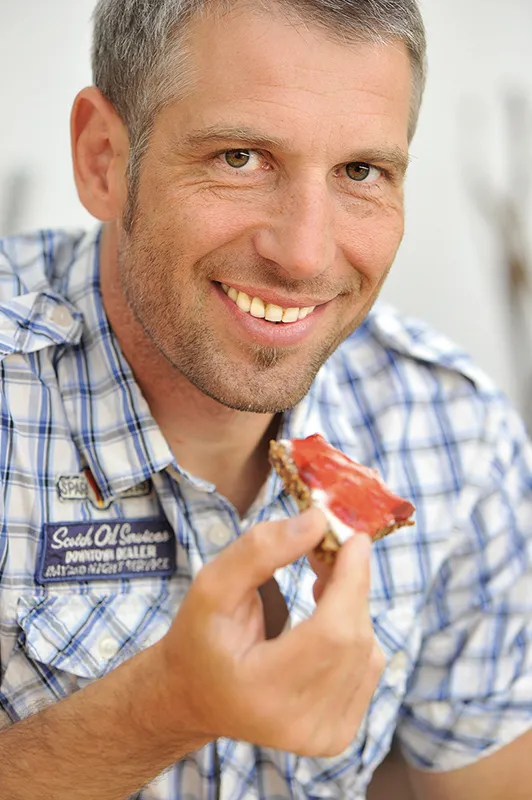
(Photo © 2011: Jens Brüggemann - www.jensbrueggemann.de)
Quite a few people photographers emphasize how important it is to establish a relationship of trust between the photographer and the person in front of the camera in order to create authentic and unforced photos. In her book "At Work", Annie Leibovitz describes how she sometimes visits the celebrities to be photographed days or even weeks before she even picks up her camera and accompanies them during their everyday work.
In this way, she ensures that she is no longer perceived as a "foreign body", but instead as familiar or even part of the crew. Of course, such an approach is not always possible, nor is it necessary. But one thing can be deduced from this for our (people) model photography: The chance of exceptional and authentic photos increases with the amount of (preparation) time available.
The shoot itself doesn't necessarily have to take hours if the photographer and model have already taken enough time to get to know each other and adjust to each other. Many photographers therefore prefer a meeting before the actual shoot. This serves the purpose of getting to know each other, discussing the image idea and adjusting to each other. If this is not possible, for example because the model has been booked for a job from further away and has only traveled or flown in for the photo shoot, it is all the more important that the photographer takes enough time to make small talk with the model before the shoot begins.
Successful photographers are aware of the importance of this time to get to know each other, which is why they often refuse shoots under time pressure. This is not an expression of an "artistic whim" or even arrogance, but a simple calculation that you need enough time for photo shoots of a certain level of creativity and quality.
Figure 1-5: Only when the model feels comfortable does the smile really look genuine. The task of a good photographer is therefore to create an atmosphere of trust so that the model can concentrate fully on the photos and forget any everyday worries for the duration of the photo shoot. However, this is not possible under time pressure, which is why the photographer should either take the time to get to know the model before the shoot or, if possible, not work under time pressure during the shoot itself.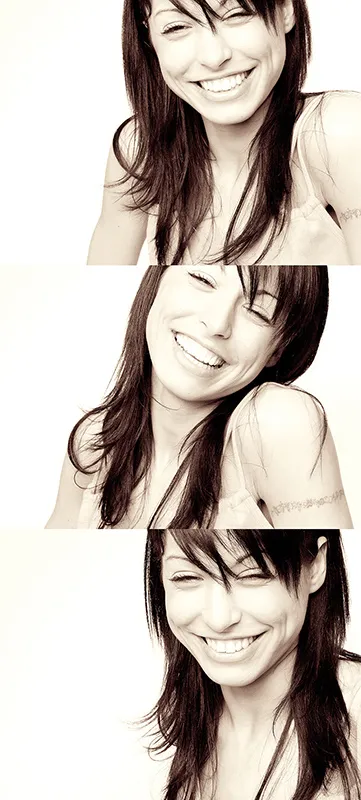
(Photo © 2010: Jens Brüggemann - www.jensbrueggemann.de)
In addition, time pressure not only prevents the creation of a relationship of trust, but is also not exactly conducive to the photographer's creativity. I myself have often found that I was just starting to take "usable" (i.e. exceptional) photos, but looking at the clock made me nervous and nipped any creativity in the bud. In short: plan enough buffer time for your shots! If you don't need it, it's no big deal; but if you have enough "breathing space", this will allow you to work more creatively and prudently (and therefore more successfully!).
1.2 Photographing children
If you want to photograph children, you need to have a "connection" to children - or to put it another way: you need to be a bit of a child yourself; that helps! You have to take children seriously, anticipate their needs and adapt to them.
You can't say to children: "Stand in front of that background, we're going to take some nice photos." It doesn't work like that.
If you want to photograph children, there are two ways to go about it. Either in the sense of observational, non-intrusive photography. Or in the sense of active participation. Then photographing or being photographed becomes a game. In this variant, it is necessary to involve the little ones, i.e. to allow them to actively participate. This can start with thinking up the picture idea, but should definitely take place during the realization. The child will remember the photo shoot in a good, fun way - which will make it easier the next time a photo shoot is due.
I've also found that children are really impressed when you show them the photos you've taken on the camera display every now and then. As a rule, they think it's really great and continue with enthusiasm.
I'm also not afraid to put my camera on the little ones myself so that they can take photos of the other kids with my help. Just make sure they don't drop the heavy camera or accidentally knock other children over with it ...!
Figure 1-6: From a certain age, around school age, you can "bribe" the "little ones" with modeling fees if they are no longer overly enthusiastic about being in front of the camera (as they were in previous years). After all, even young boxers already have consumer desires, such as the latest Nintendo game or the new collection of Star Wars trading cards.
However, persuasion works better than bribery: If you find a "cool" idea that the mini-models are happy to go along with - for image reasons vis-à-vis their classmates - it's always more promising than the mini-jobber variant. Nikon D3X with 1.4/85mm Nikkor. 1/125 second, Blender 4, ISO 100.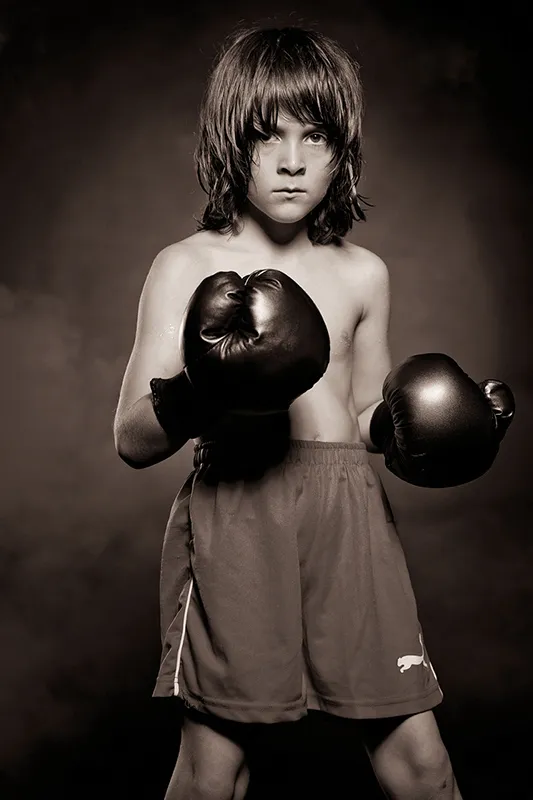
(Photo © 2011: Jens Brüggemann - www.jensbrueggemann.de)
What children don't like at all are posed photos in which they are supposed to stand still. The famous family photo to be given to grandma for Christmas is not exactly what kids enjoy.
It's better to let them make nonsense or grimace. Action photos are also popular, for example photos of them jumping, running around or climbing trees.
Figure 1-7: Children love action photos. If they think the photos are "cool", they will - for once - run up and down the beach several times, which would otherwise be unthinkable! Nikon D700 with 4/24-120mm Nikkor. 1/800 second, Blender 7.1, ISO 200.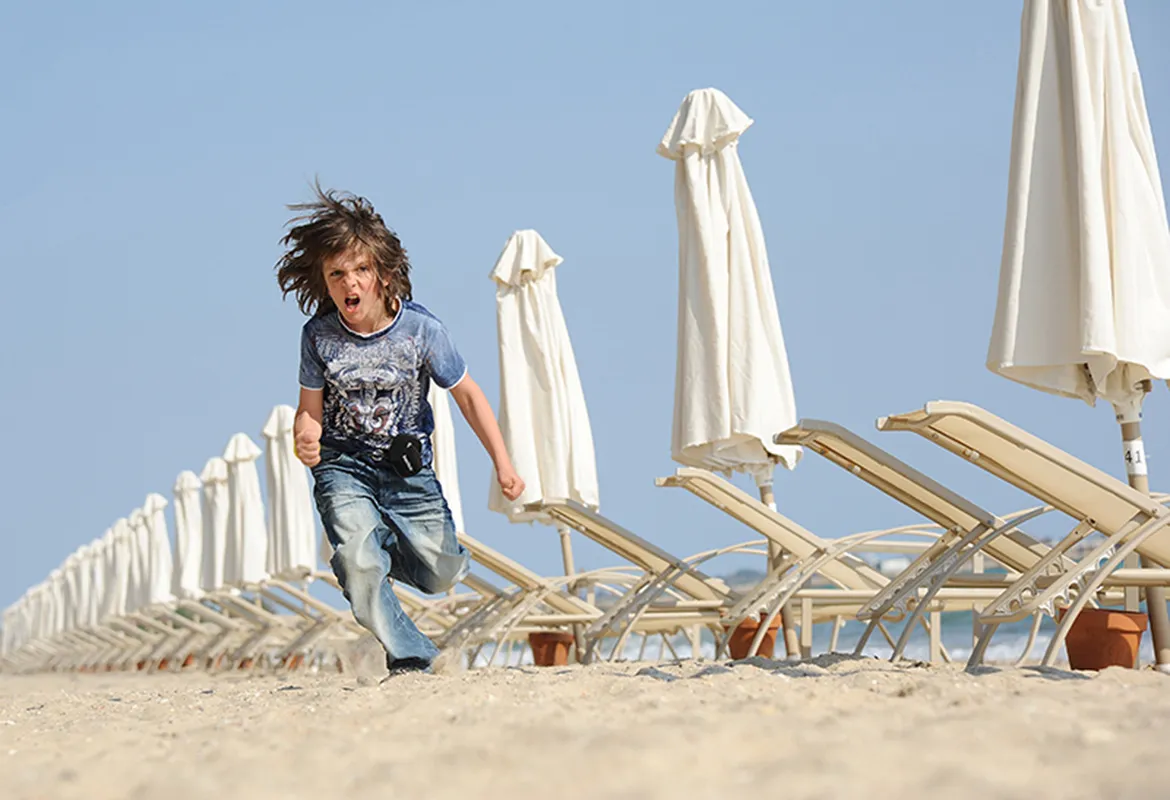
(Photo © 2010: Jens Brüggemann - www.jensbrueggemann.de)
Figure 1-8: When the children are allowed to make faces, they like to pose. Nikon D3 with 2.8/24-70mm Nikkor, with 24mm focal length used. 1/50 second, Blender 5, ISO 1600.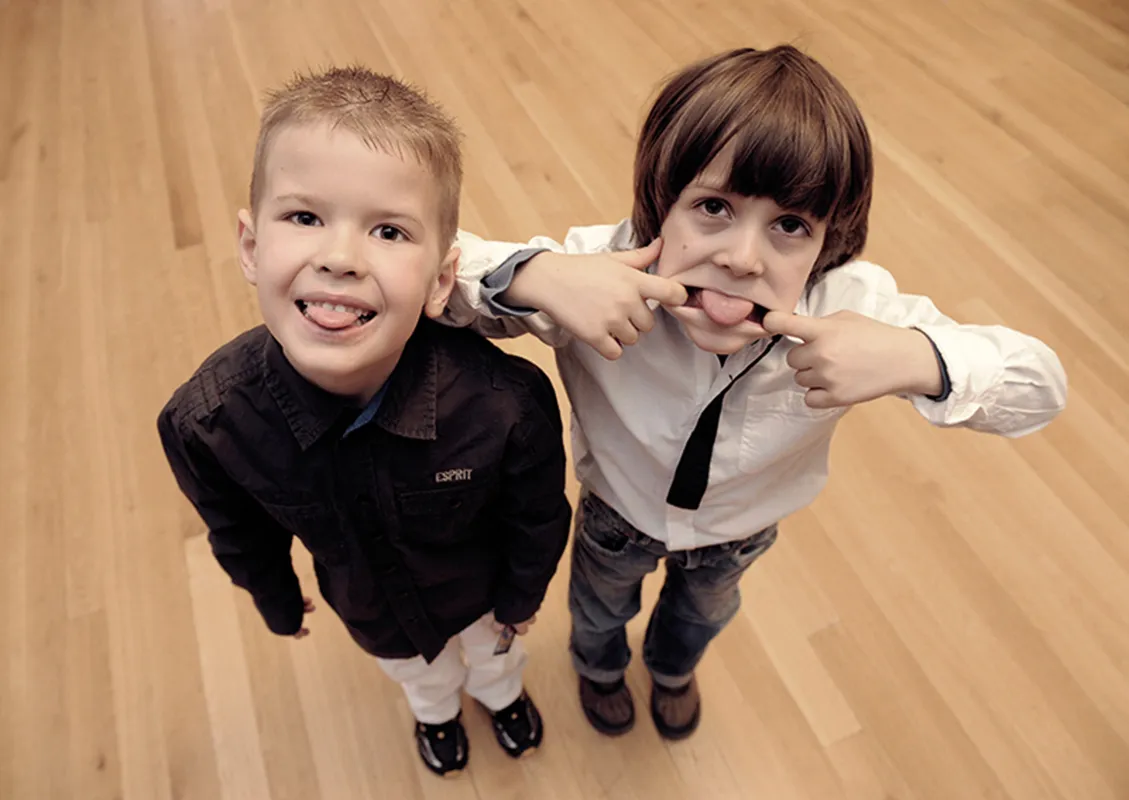
(Photo © 2011: Jens Brüggemann - www.jensbrueggemann.de)
With smaller children, i.e. between 12 months and 4 years, it is still very easy to attract attention (for example by shouting (or singing a song with younger children), waving, imitating animal sounds, holding a favorite cuddly toy over the camera, etc.) - so that nice shots are actually quite easy to take. However, the attention span of young children is relatively short, which is why you should hurry with the photos.
Figure 1-9: A new toy car - and little Flynn is busy enough - at least for a few minutes - so that he can be photographed in peace. Old toys, on the other hand, would not have this attention-grabbing effect, which is why it is advisable for children's photographers to always have toys in stock that the little ones do not (yet) know. Fortunately, the color of the new toy car matched Flynn's outfit, which played a significant role in the effect of the picture. Nikon D4 with 1.4/85mm Nikkor. 1/400 second, Blender 2.5, ISO 400.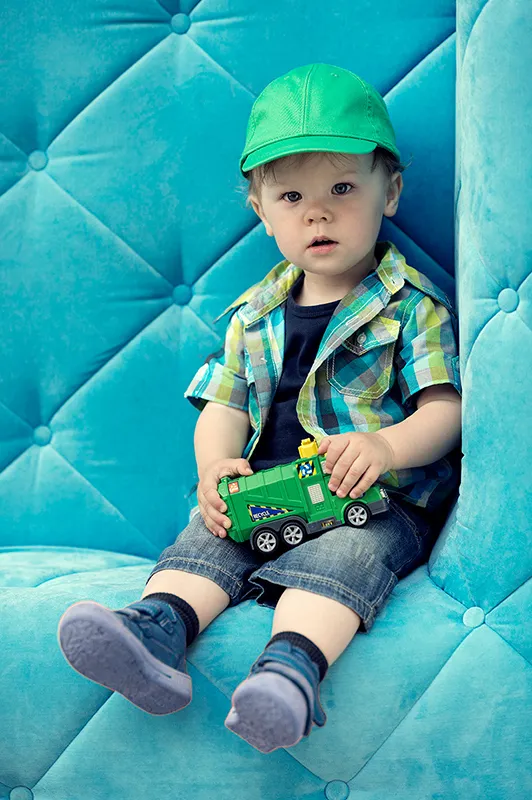
(Photo © 2013: Jens Brüggemann - www.jensbrueggemann.de)
Note
Praise helps children (and adults too) immensely. Anyone who is praised for how great he (or she) is at modeling is proud and will try even harder from then on.
But be sure to give the children short breaks in between! Nobody wants to be constantly followed by the camera - and certainly not during the breaks. A small snack or an ice cream in between, and the little ones will be fresh and ready for new photos.
When changing the background in the studio, for example, it's a good idea to let the young models lend a hand. This makes them feel important and grown-up enough to help. It is also helpful to introduce ideas, even if not everything the little ones suggest can be realized. The development of team spirit is crucial and is definitely of value for the later photos. Here too, a model who identifies with the task is 1000 times more motivated than a model who just follows instructions.
During the shoot, which should be well prepared (with background and light set-up, exposure tests, etc.), you should be flexible enough to be able to take snapshots from time to time. This is because the mini models are in a good mood and don't follow a set-up or schedule. They are always up to mischief, make faces and curiously take in their new surroundings. It's best if you prepare a camera specifically for this purpose, equipped with a system flash unit that meets the requirements for snapshots (automatic exposure, zoom lens, fast autofocus, higher ISO value, etc.).
Tip
"One of the most common mistakes adults make when photographing children is taking photos from their normal ("bird's eye") perspective. This is often boring and often enough inappropriate, as the little ones have to constantly look up to be able to look into the camera. So it's better to squat down or even lie on your stomach on the floor! The unusual perspective will definitely make the shots much more interesting, I promise! Just give it a try!" (from: "Babys und Kinder fotografieren"; J. Brüggemann and L. Ebert; mitp-Verlag; ISBN: 978-3826690624; 204 pages; 29.95 euros).
Fig. 1-10: I always try to stay at eye level with the little ones when taking photos of children. However, this seemed to be unusual for Lennox, as he stared at me in surprise for quite a while, which I took advantage of to take a few nice portraits of him. Nikon D3 with 2.8/300mm Nikkor. 1/800 second, Blender 4.5, ISO 200.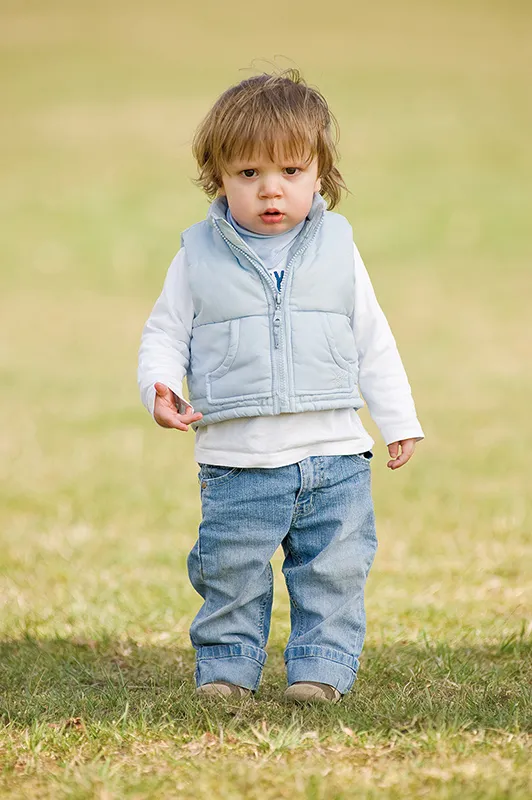
(Photo © 2012: Jens Brüggemann - www.jensbrueggemann.de)
Note: Children should only be photographed as long as they are still having fun! Unfortunately, children's moods change very quickly at some point, but as an adult (photographer) you should definitely respect this.
1.3 Beauty photos
When you take beauty photos, you try to make beautiful people even more beautiful. I have already revealed the first important "ingredient" in the "beauty photography" recipe for success: Experienced beauty photographers choose the most beautiful models for their photos wherever possible.
Even if some of the readers now think "Well, I could take such photos with such a good-looking model", they fail to realize that the tasks of a model photographer not only include mastering time, aperture, ISO, autofocus and lighting, but also casting the models. Good photographers have an eye for new talent, for photogenicity.
Note: Finding new models is a task that many photographers find difficult, which is why I will be addressing this topic in detail later in this tutorial series.
Beauty photography requires models to be well made up. However, not every model can apply make-up well, which is why it makes sense to use make-up artists.
Figure 1-11: One of the "ingredients" of beauty photos is that the model not only looks great, but is also as well made up as possible. Nikon D4 with 2.0/200mm Nikkor. 1/125 second, Blender 3.5, ISO 125.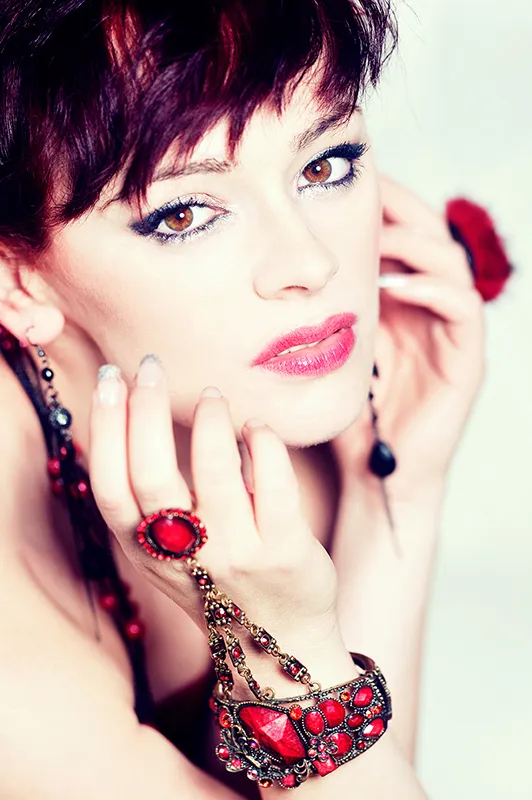
(Photo © 2012: Jens Brüggemann - www.jensbrueggemann.de)
Tip: Sometimes, however, it happens that the model is professionally and well made up, but gets a fright after the make-up because she doesn't recognize herself. Quite a few women have a problem when they are made up differently than they are used to.
They don't recognize themselves - and feel uncomfortable in their own skin. In such cases, you can safely do without a make-up artist - it would be a waste of money. So clarify beforehand whether your model is ready to be "enchanted". Or whether they just want to look the same as always.
Figure 1-12: For beauty photos, it should go without saying that the model should appear at the photo shoot with her nails done and/or well-groomed. As a precaution, point this out to your model during the preliminary talk.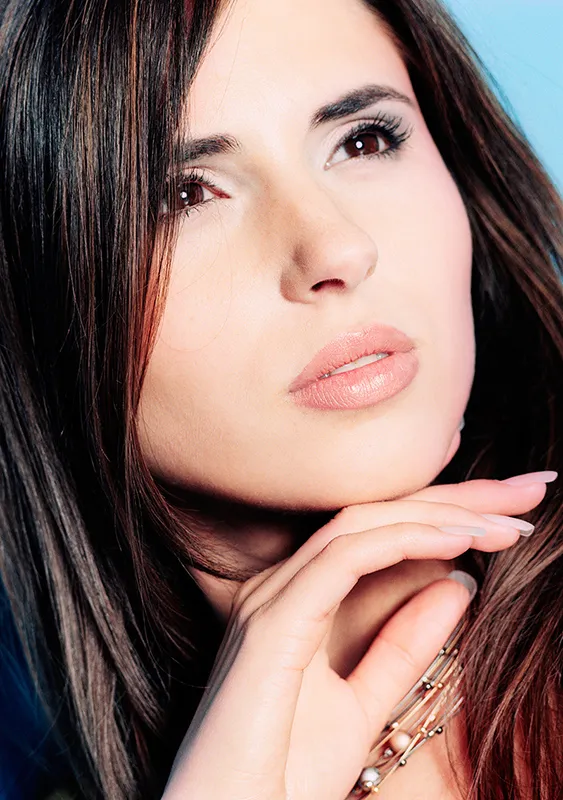
(Photo © 2006: Jens Brüggemann - www.jensbrueggemann.de)
Beauty photographers should not only have a feel for colors, shapes and image design, but also be creative and willing to work hard for the "perfect photo". Working in a team (for example with a make-up artist and hairstylist) is standard in everyday professional life, but this also requires skill.
Furthermore, the beauty photographer should not be impressed by the appearance of the models. After all, beauty is a basic requirement for working as a beauty model. However, reliability and the ability to work in a concentrated team are also more important here.
Unfortunately, I have often seen particularly good-looking (very young) models think that their looks allow them to be unreliable and unprofessional. But fortunately, there are enough beautiful models out there, and as mentioned above, no photographer should "put up" with the diva-like behavior of an imaginary model.
Figure 1-13: The model pictured, Sandra, has the title of "Miss Germany". Nevertheless, some of the participants in my Ibiza workshop in 2012 found her more difficult to photograph than other models who were also present at the workshop. I have observed this phenomenon more often: Models with "Miss titles" look great and have great measurements - but they are often not exceptionally photogenic.
Of course, with a little photographic experience and concentrated work, you can still take great photos with them! But it's often easier with other models (because they are more photogenic). Nikon D3X with 2.8/105mm macro Nikkor. 1/125 second, Blender 3.5, ISO 200.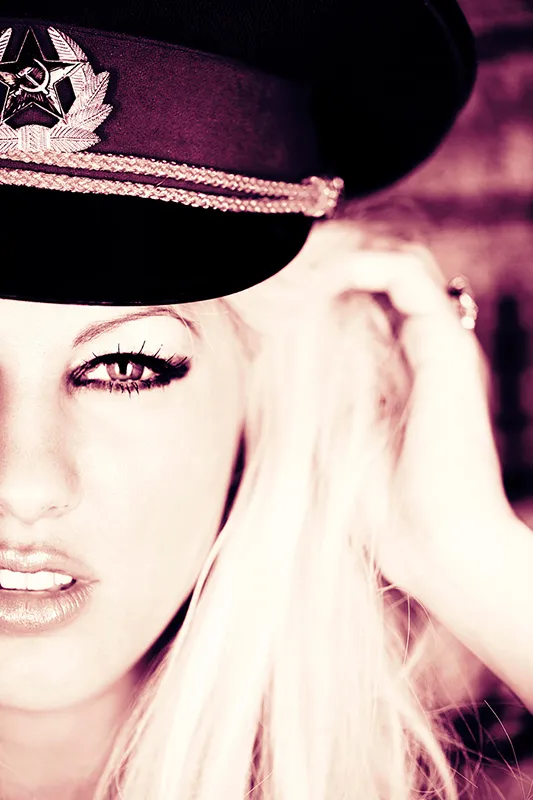
(Photo © 2012: Jens Brüggemann - www.jensbrueggemann.de)
Note: What a beauty photographer should be able to do from a photographic point of view will follow in the next parts of this tutorial.
1.4 Fashion photography
In fashion photography, it's not just about having pretty models, but also about presenting the clothes correctly. In addition to photographic know-how, fashion photographers should therefore have a good sense of fashion and a feel for trends in order to be successful.
Figure 1-14: Colors and props play a major role in fashion photography. If you are unsure which combinations "work", it is better to book a stylist for commissioned work. Since I believe that as a photo designer I am responsible for the design of the entire photo content, including all the individual image elements, I don't let anyone do this important work for me.
Nikon D3 with 2.8/105mm Macro Nikkor. 1/160 second, Blender 8, ISO 200.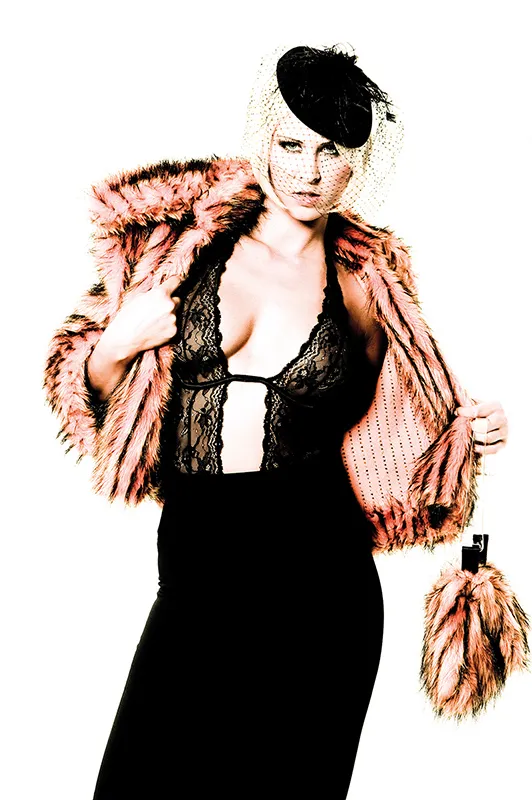
(Photo © 2008: Jens Brüggemann - www.jensbrueggemann.de)
Fahion photography can be subdivided into photographing models and photographing clothes. The two are closely related, as it is not uncommon for photos of models to be needed just as much as photos of the garments. Photographers interested in this field should therefore be aware that they will have to deal with both areas of photography if they want to work as a fashion photographer.
Figure 1-15: In fashion photography, depending on the style of the garments, it is often necessary to make the model look "cool". A casual pose, suitable props and an effective background are the ingredients to achieve this. Here I have used my Para flash umbrella as a background. Nikon D3X with 1.4/85mm Nikkor. 1/80 second, Blender 2.5, ISO 100.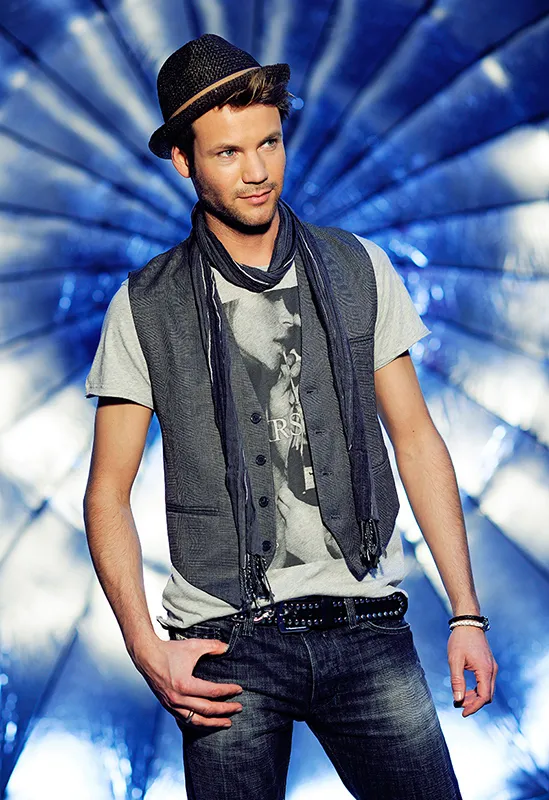
(Photo © 2012: Jens Brüggemann - www.jensbrueggemann.de)
Fashion photographers should not only be aware of fashion trends, but also of other current social developments. Anyone who photographs fashion is expected to have the relevant knowledge; and nothing would be worse than combining clothes from a label that is currently all the rage with accessories that have been completely "out" for months.
Of course, the choice of background also plays an important role in the presentation of fashion. Here, too, the fashion photographer must demonstrate a sure instinct in order to present the goods in a way that is appropriate for the target group. In the fast-moving world of fashion, there is a lot of money to be made. The advertising photos play a decisive role in success or failure.
Figure 1-16: Especially with fashion photos, the right background plays an important role in presenting the clothing in a way that is appropriate for the target group. For example, elegant beachwear is presented in a classy summer ambience: with sun, palm trees or a pool in the foreground or background. Here I had rented a Schick villa for a day during my Ibiza workshop in May 2010 so that the participants had a typical "high society" looking location for their fashion photos.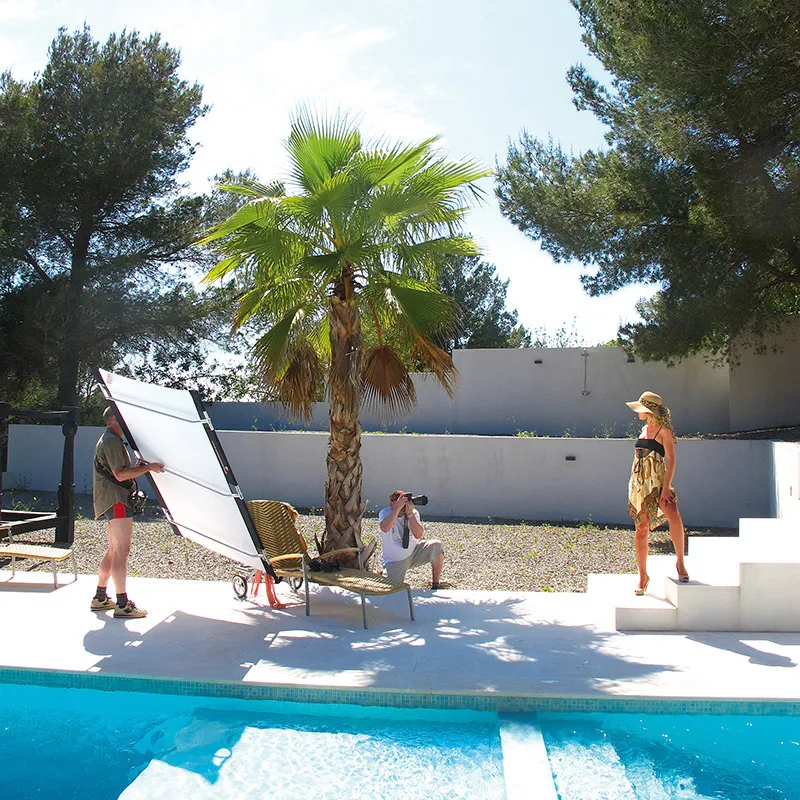
(Photo © 2010: Jens Brüggemann - www.jensbrueggemann.de)
As a rule, with fashion photos, care must be taken to ensure that the clothing fits well and that the colors are reproduced as true to color as possible. Highlighting the texture of the fabric by means of targeted lighting is also part of a good fashion photo.
It is a challenge for every photographer to photograph black clothing according to the customer's wishes: Especially with certain fabrics (for example velvet or wool), when the product is deep black, it is very difficult to reproduce the fabric texture photographically. Double or quadruple the amount of light has to be used to get the black areas to show the pattern. The trick is to overexpose only the fabric and not the model.
Figure 1-17: Glossy black fabrics such as lacquer and leather are completely unproblematic. Due to the reflections on the smooth, shiny fabric, the cut and fit can be easily assessed. However, the situation is different with soft matt black fabrics: These "swallow" the light so that patterns, seams, pockets and other contrasting details cannot be recognized. The result would be a single black mass with no pattern.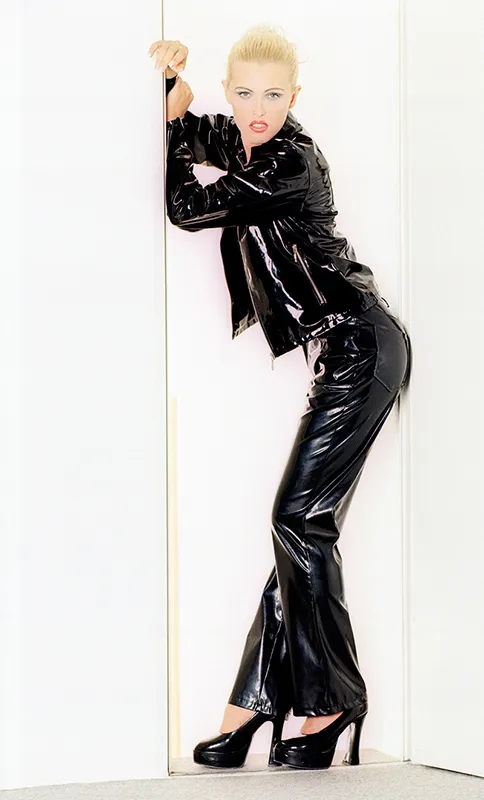
(Photo © 2012: Jens Brüggemann - www.jensbrueggemann.de)
Figure 1-18: In free fashion work, TFP shoots, which are done by photographers and models for practice, for the portfolio or for self-promotion, it is usually the case that the model arrives almost exclusively in black clothing. The "little black dress", tight-fitting and figure-accentuating, seems to be in every model's closet. However, our eyes see better than the camera; our eyes can still recognize patterns even in matt black fabrics - where the camera only sees "black".
The result is often disappointing, because the little black dress looks far more attractive "live" than in photos. So be careful when it comes to black clothes in fashion shots! Check your photos for details and exposure to avoid any nasty surprises afterwards! (In this case, however, I was lucky that at least the sleeves had lace on the outside and the skin could shine through in places. And the blue bag in this photo on the right also helps to break up the monotonous black of the dress).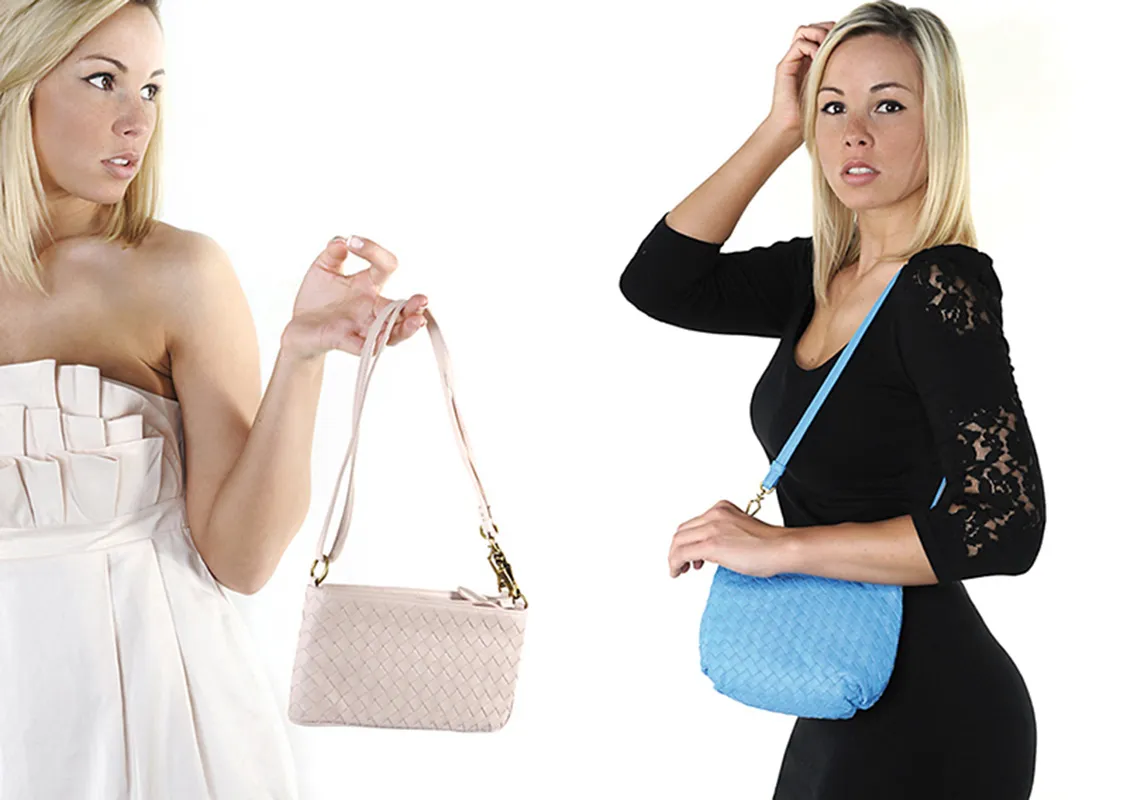
(Photo © 2012: Jens Brüggemann - www.jensbrueggemann.de)
1.5 Nude and erotic photography
Nude and erotic photography are often referred to as the "supreme disciplines" of photography. However, this is not entirely understandable to me, because taking a good nude photo is no more difficult than taking a good portrait or fashion photo. As I have been involved in nude photography for quite a long time, I can even say that I personally find it more difficult to take a good landscape photo than a good nude or erotic photo. (But that may also be because I don't like getting up early in the morning ...)
But there is a relevant reason why many photographers refer to nude and erotic photography as the "supreme discipline". Because with all other photographic subjects, it doesn't matter whether the result is successful or not. For example, your landscape doesn't care if the photographer has messed up the shot. The animal also doesn't care whether it was photographed well or badly. And even with portraits, the person being photographed may be annoyed if he or she has been photographed unfavorably, but that is by no means the "end". With nude or erotic photos, on the other hand, a bad result means that the photos quickly look embarrassing, which is the ultimate disaster for the person photographed, especially if the photos are also to be published.
In summary, it can be said that nude and erotic photography is not necessarily more difficult or more demanding. It's just that the consequences of bad photos are much more far-reaching. Therefore, nude and erotic photographers should never show all photos (to the public, the model, etc.); only the best selected and slightly edited results should be presented.
But what is the difference between nude and erotic photography?
Figure 1-19: The areas of nude and erotic photography can best be imagined as two sets that have a common intersection. This makes it clear that there are nude photos that can do without eroticism. And conversely, there are erotic photos that are not nude photos. Thirdly, there are also erotic nudes, i.e. photos that belong to both areas.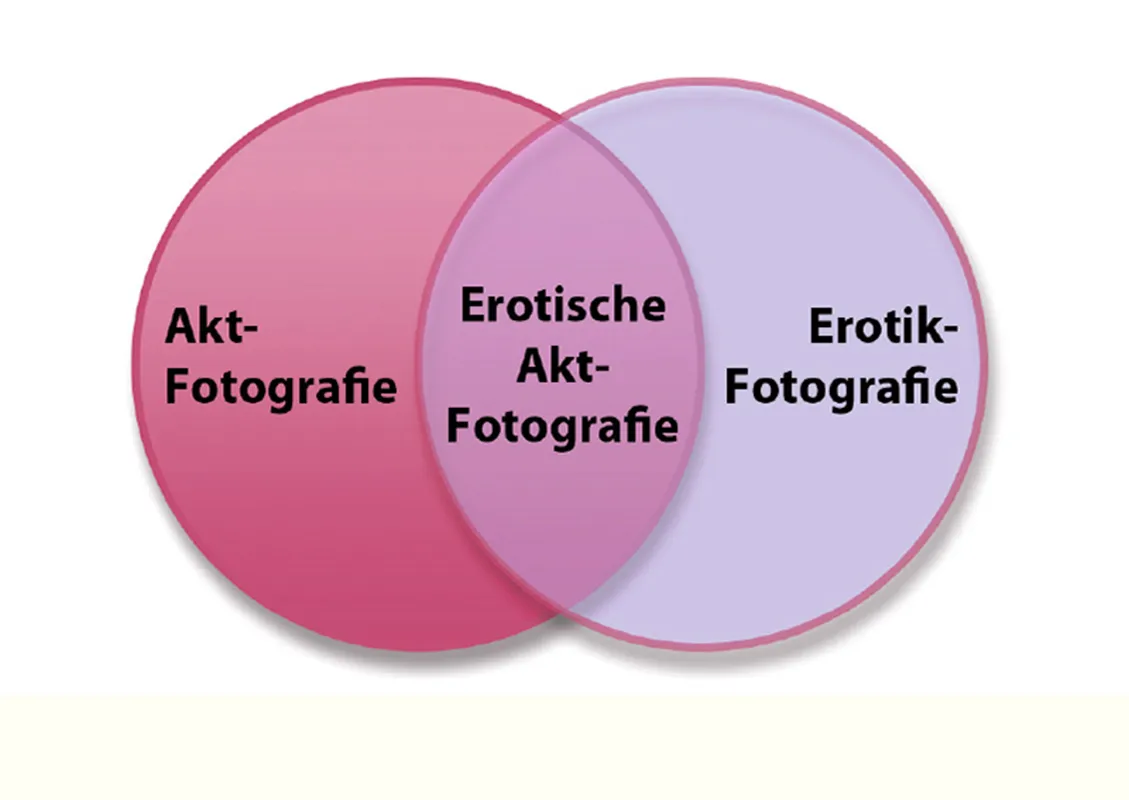
Nude photos are photos that have the naked body as their subject. Often in an abstract and mostly idealized form. However, documentary nudes are also conceivable. However, the majority of published nude photos were subjected to the ideal of beauty.
Figure 1-20: Classic nude photography is the photography of the (usually beautiful) body; often anonymized. Unlike erotic photography, classic nude photography does not necessarily require personification. Photographing individual body details - often with the help of light and, above all, shadow - is enough to achieve effective and usually aesthetically pleasing results.
A certain degree of abstraction underlines the photographer's desire to create timelessly beautiful body views. This is another reason why I chose this photo for the cover of my new book "Nude and Erotic Photography". Nikon D3X with 2.8/70-200mm Nikkor. 1/160 second, Blender 22, ISO 100.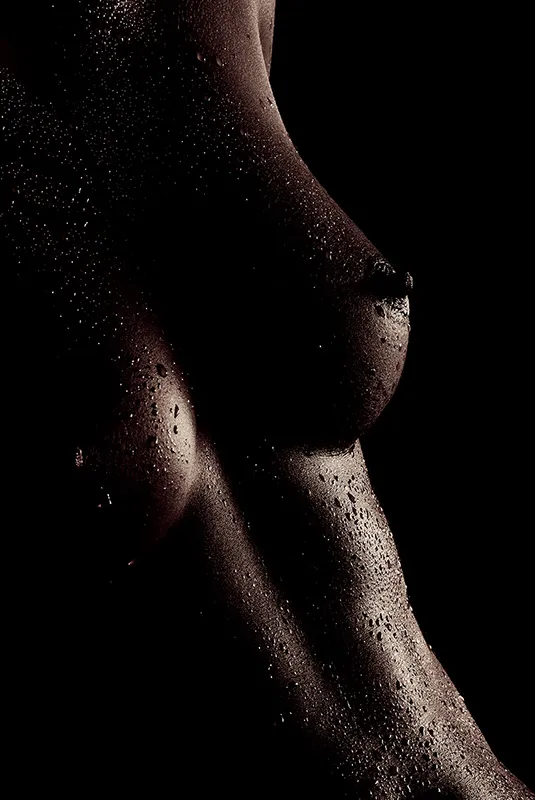
(Photo © 2012: Jens Brüggemann - www.jensbrueggemann.de)
Erotic photos, on the other hand, are not dependent on the nudity of the body shown. In erotic photography, it is the (erotic) image statement that counts. Suggestion plays an important role here.
The viewer's imagination should be directed in a certain direction, which can be achieved in many ways: a promising look, a sexy pose, certain signal colors, selected clothing such as sexy lingerie, matching props, the suggestion of touching by the model's hands, a pout, etc. There are no limits to the erotic fantasy. There are no limits to the erotic imagination.
Figure 1-21: When models pout, show their breasts and tug at their tight-fitting clothes, the results are of course erotic in nature. Eroticism is not so much what the viewer sees - but what he (or she) imagines. Thinking ahead (!) is what makes eroticism. The viewer's imagination is stimulated. As a result, he or she no longer sees the photo as a static image of an attractive person, but as a starting point for further thoughts ... Nikon D3X with 2.8/24-70mm Nikkor. 1/200 second, Blender 11, ISO 200.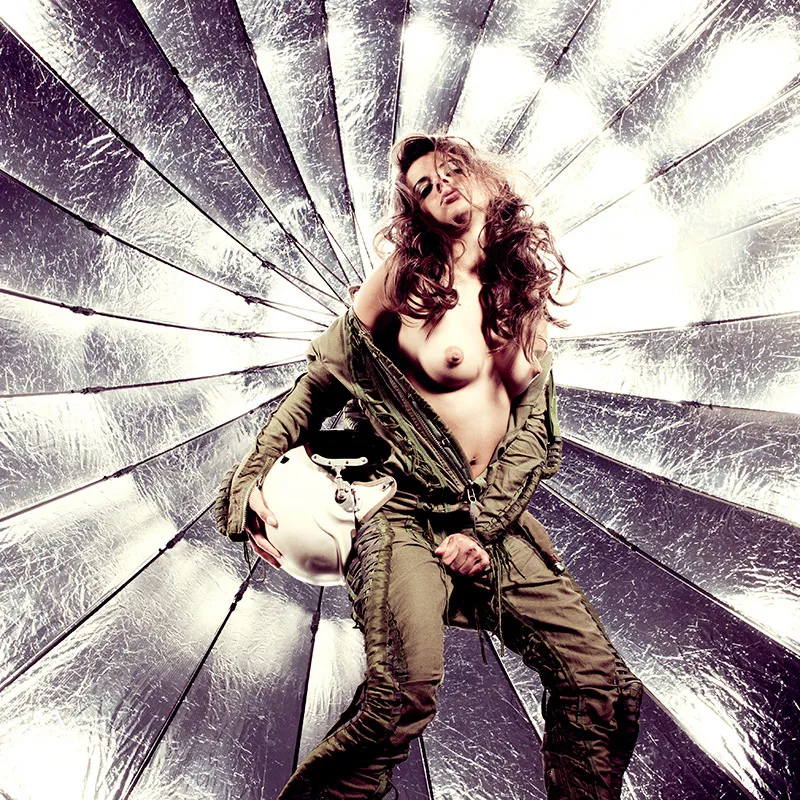
(Photo © 2011: Jens Brüggemann - www.jensbrueggemann.de)
The decisive factor is that erotic photography deliberately plays with the viewer's imagination. They should think ahead. Therefore, not "everything" is usually shown, because the suggestion is sufficient. The (erotic) photo merely provides the stimulus. The rest is done by the viewer's brain ... Figure 1-22: A very dynamic, sexy pose! Here you can see how effective body language can be in erotic photography! Nikon D3S with 2.8/24-70mm Nikkor at a focal length of 29mm. 1/160 second, Blender 4.5, ISO 800.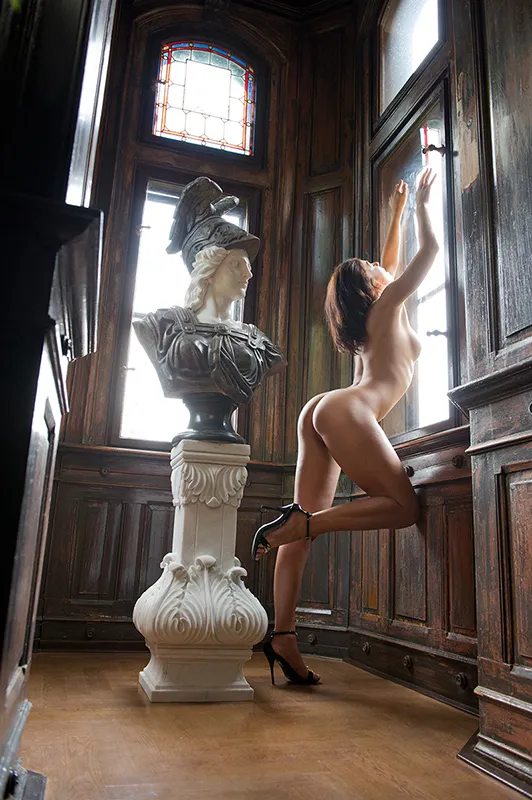
(Photo © 2010: Jens Brüggemann - www.jensbrueggemann.de)
What requirements must a good erotic photographer fulfill? First of all, they should understand their craft, i.e. deliver technically flawless work. In addition, the photographer should be open-minded and not uptight. Anyone who has moral problems with this, i.e. who secretly thinks that showing themselves in front of a camera is not appropriate, should photograph something else! In other words: Nudity should be seen as something natural - and not as something unseemly or even depraved.
Erotic fantasies will also be helpful in finding image ideas before a shoot. However, this does not necessarily mean that only your own fantasies should be photographed. In order to have variety in my photos, I often take inspiration from the models. Incorporating the model's ideas is also a good way to avoid boredom, and it also ensures that the model is motivated to take part in the shoot (if their ideas are taken up and implemented).
Figure 1-23: As a "lone wolf", it is not always easy to achieve professional results. Involving the model is one way to gather ideas. But there are also situations where a helping hand would be very useful, if only to hold a brightener (right in the picture) or shading (left in the picture).
In my international photo workshops, the participants are therefore divided into groups (3 participants each); they take turns photographing individually, so that each photographer has two helpers to assist him in realizing his picture idea. This increases the technical quality of the photos enormously!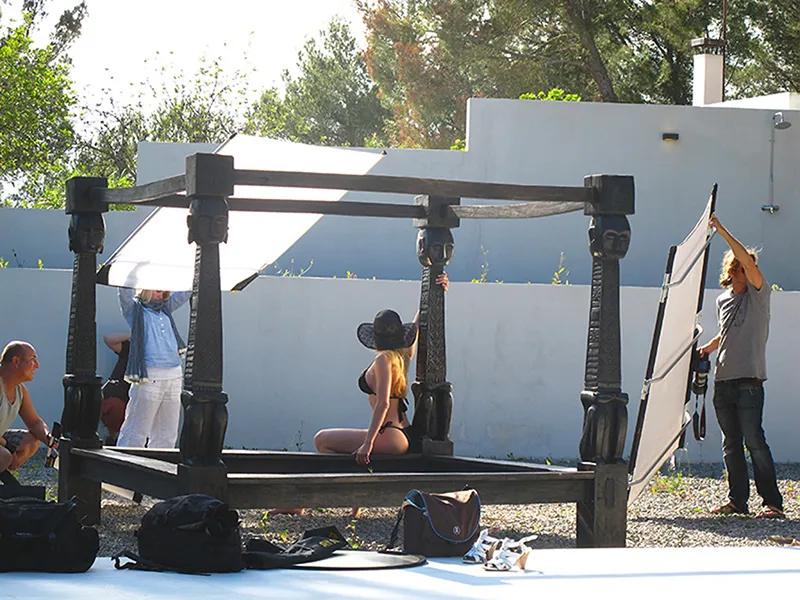
(Photo © 2010: Jens Brüggemann - www.jensbrueggemann.de)
Note: The decisive factor in nude and erotic photography, however, is that the photographer approaches the photo shoots respectfully and sensitively. Only those who respond to the needs of the model will take photos in which the person in front of the camera feels comfortable, which is the most important prerequisite for good pictures! And this brings us full circle, because in model photography in general, the photographer's skills and above all the good cooperation between the two are just as important as the model's good looks!
